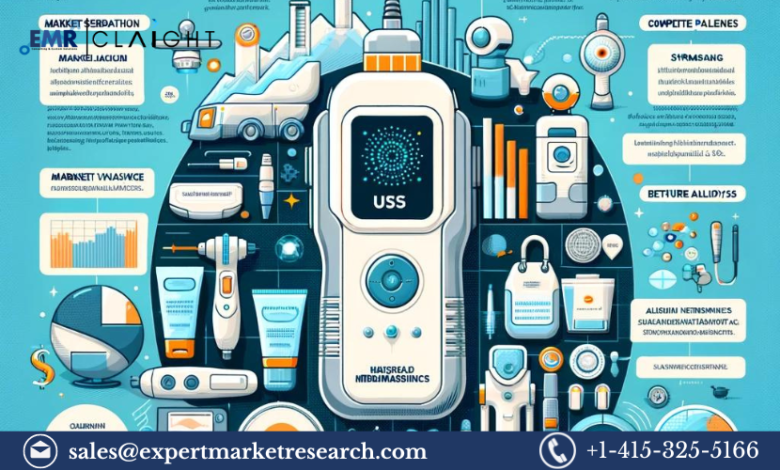Microdermabrasion Devices Market: Trends, Growth, and Key Players 2032

The microdermabrasion devices market has seen significant expansion, with a valuation of USD 590.38 billion in 2023. This is projected to grow to USD 1293.75 billion by 2032, driven by a CAGR of 9.1%. Microdermabrasion is a sought-after skincare treatment that offers a non-invasive way to exfoliate the skin, enhancing its texture and appearance. Popular in clinics and increasingly accessible for at-home use, microdermabrasion is part of a larger trend towards minimally invasive cosmetic procedures.
Market Overview: What is Microdermabrasion?
Microdermabrasion is a procedure that removes dead skin cells from the outer layer of the skin using small crystals or a diamond tip. This technique promotes collagen production and improves the skin’s overall look, helping to address issues like dullness, fine lines, and acne scars. Traditionally performed by dermatologists and aesthetic clinics, the procedure has gained popularity for its quick recovery time and immediate results. With the increasing availability of home-use devices, microdermabrasion has become accessible for consumers who prefer self-care solutions.
Key Market Drivers: Why is the Market Growing?
- Increased Demand for Minimally Invasive Procedures: Modern consumers favor procedures that don’t require surgery or lengthy recovery times. Microdermabrasion fits perfectly into this preference, offering quick, visible results with minimal discomfort.
- Rising Beauty and Wellness Trends: Consumers are increasingly interested in skincare routines that prevent aging and maintain a youthful appearance. The growing beauty culture, fueled by social media, has made treatments like microdermabrasion more popular.
- Technological Advancements: Companies are continuously developing devices that are safer, more effective, and easier to use. Innovations such as adjustable intensity levels, various exfoliation tips, and integrated vacuum suction enhance the overall experience and attract a broader audience.
Latest Trends in the Microdermabrasion Devices Market
- Home-Use Devices: The COVID-19 pandemic accelerated the trend towards at-home skincare solutions. With increased consumer interest in self-care routines, brands like Koninklijke Philips N.V. have introduced home-use devices that deliver spa-like results.
- Eco-Friendly Product Development: Sustainability has become a major concern for consumers. In response, some brands are investing in eco-friendly materials, biodegradable parts, and recyclable packaging for their devices, aligning with the global movement towards environmental responsibility.
- Integration with Other Treatments: Many devices now offer a combination of treatments. For instance, microdermabrasion tools with LED light therapy or devices that infuse serums directly into the skin post-exfoliation are increasingly popular. This trend reflects consumer demand for comprehensive, multi-functional beauty solutions.
Market Segmentation: Understanding Different Product Categories
To understand the market’s diverse offerings, let’s break down the segments:
- By Device Type:
- Crystal Microdermabrasion: This traditional method uses fine crystals to exfoliate the skin. It is known for deep exfoliation and is widely used in professional settings.
- Diamond Microdermabrasion: This method utilizes a diamond-tipped wand, which is more controlled and can be gentler on the skin, making it suitable for sensitive areas. It’s increasingly popular in both clinical and home-use devices.
- By Application:
- Anti-Aging: Microdermabrasion stimulates collagen production, reducing fine lines and wrinkles.
- Acne Treatment: The exfoliation process can help clear pores and reduce acne breakouts.
- Hyperpigmentation: Regular treatments can help reduce dark spots and even out skin tone.
- By End-User:
- Dermatology Clinics: Professional-grade devices that provide intensive treatments.
- Beauty and Aesthetic Clinics: These offer a wide range of skincare treatments, including microdermabrasion.
- Home-Use Settings: Growing in popularity, home devices provide convenience and cost savings.
Regional Insights: Where is Demand Growing?
- North America: As the largest market for microdermabrasion devices, North America benefits from high consumer spending on skincare and aesthetic treatments. The region’s strong presence of top manufacturers and the popularity of beauty treatments support market growth.
- Europe: European consumers are known for their preference for natural, minimally invasive skincare treatments. Regulations around beauty and wellness are strict, making Europe a competitive but lucrative market.
- Asia-Pacific: Rising disposable incomes and increased interest in beauty treatments make this region a fast-growing market. Countries like South Korea and Japan, known for their beauty-focused cultures, are hotspots for the latest skincare trends.
- Latin America: With emerging markets in Brazil and Mexico, the beauty industry in Latin America is rapidly evolving, driven by growing awareness of aesthetic treatments.
- Middle East & Africa: While still developing, the market is expanding as disposable income rises and consumers seek beauty treatments similar to those available in more developed regions.
Key Players and Their Strategic Moves
- AbbVie Inc.: AbbVie has a strong presence in the aesthetics market, especially after acquiring Allergan, a leader in medical aesthetics. The company is committed to R&D and regularly launches innovative products.
- Koninklijke Philips N.V.: Known for high-quality consumer electronics, Philips is leveraging its brand to dominate the home-use microdermabrasion market. The company focuses on usability and safety, making it popular for at-home treatments.
- Altair Instruments, Inc.: The company offers a range of professional-grade products, such as the Diamondtome™ and HydroWands, which are used globally in clinics. Altair’s focus on quality and continuous innovation helps maintain its competitive edge.
- ImageDerm Inc.: Based in Los Angeles, ImageDerm is expanding its product line to meet growing consumer demand. The company prioritizes high-quality, non-invasive treatments and regularly updates its offerings.
Future Market Trends: What Lies Ahead?
- AI and Smart Technology Integration: In the coming years, we can expect to see AI-enabled devices that analyze skin and adjust treatment intensity automatically. This technology will provide users with a more personalized skincare experience.
- Sustainable and Eco-Conscious Products: As environmental consciousness grows, consumers will prefer brands that offer eco-friendly options, such as devices made from sustainable materials or those that use minimal packaging.
- Enhanced At-Home Experience: With consumers continuing to demand high-quality at-home treatments, manufacturers are likely to release even more sophisticated home-use devices, making it easier to achieve spa-like results at home.
Investment and Funding Analysis
- Patent Activity: Companies are continuously developing and patenting new technologies to stay ahead in the competitive market. Patents focus on unique features, such as adjustable exfoliation levels, safety measures, and device ergonomics.
- Strategic Partnerships and Acquisitions: Mergers and acquisitions, such as AbbVie’s acquisition of Allergan, are common in this market. These strategies allow companies to expand their product lines and improve market penetration.
- Funding Trends: Investments in aesthetics and dermatology are growing, as venture capital firms and private equity investors see the potential for substantial returns. This funding is instrumental in supporting R&D for innovative devices.
Conclusion: The Future of Microdermabrasion Devices
The global microdermabrasion devices market shows no signs of slowing down. With advances in technology, increasing consumer demand for at-home solutions, and a shift towards sustainable practices, the future holds tremendous potential. Companies that focus on innovation and respond to evolving consumer preferences will likely emerge as leaders in this expanding market.
FAQ: Common Questions About Microdermabrasion Devices
- What is the difference between crystal and diamond microdermabrasion?
- Crystal microdermabrasion uses fine crystals for exfoliation, while diamond microdermabrasion uses a diamond-tipped wand for more controlled and often gentler exfoliation.
- Are at-home devices as effective as professional treatments?
- Home devices can offer effective results but may not be as powerful as those used by professionals. Regular use of home devices can still deliver visible improvements over time.
- What is the recovery time after a microdermabrasion session?
- Microdermabrasion has minimal recovery time. Most users experience some redness immediately afterward, which usually subsides within a few hours.
- How often can I use a microdermabrasion device at home?
- Generally, it’s safe to use a home device once a week, but it’s always best to follow the manufacturer’s instructions for optimal results.





